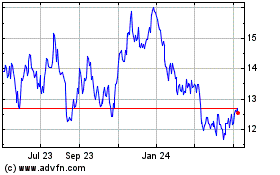BHP Shares Plunge as Brazil Files Suit Against Dam Owners -- Update
November 30 2015 - 9:34AM
Dow Jones News
By Rhiannon Hoyle and Alex MacDonald
Shares in BHP Billiton Ltd. fell to a more than 10-year low on
Monday after the Brazilian government said Friday it would sue the
Anglo-Australian miner, its Brazilian partner Vale SA and their
joint venture over a deadly dam failure earlier this month.
The lawsuit, which is set to be officially filed on Monday, will
demand damages of roughly 20 billion Brazilian reais (roughly $5.2
billion), the Attorney General's office said on Friday, for a fund
to help recovery efforts in the Rio Doce, a major river
contaminated when a dam holding mine waste broke on Nov. 5 at an
iron-ore operation in Brazil's Minas Gerais state.
At least 13 people were killed and six remain missing, BHP said.
The dam burst unleashed a torrent of waste that the U.N. called
"toxic," turning the Rio Doce orange in recent weeks and sending a
plume of material into the Atlantic Ocean. Hundreds were displaced
and entire villages were destroyed.
BHP's shares in London fell 3.6% on the day to a seven-year low
of 778.9 pence a share on Monday morning while its shares in Sydney
closed at a more than 10-year low of 18.09 Australian dollars
($13.01) each, down 3.6% on the day. This compares with a 0.5% drop
in the U.K.'s FTSE 350 mining index and 0.4% drop in the London
shares of fellow Anglo-Australian mining peer Rio Tinto PLC.
BHP, the world's largest mining company by market value, said in
a news release that it hasn't been formally notified about the
civil suit but "will assess the case once it has been filed." BHP
and Vale have said their equally owned joint venture, Samarco
Mineracao SA, was legally responsible for the incident.
BHP said it was committed "to supporting Samarco to rebuild the
community and restore the environment affected by the breach of the
dams." Samarco, which is owned jointly by BHP and Vale, operates
the mine.
On Friday, Vale and BHP said they would establish a voluntary
fund for efforts to rehabilitate the Rio Doce river system,
although the mining giants didn't say how much money would be
available.
The dam incident has put new financial pressure on BHP at a time
when it was already challenged by falling prices for the
commodities it sells, especially iron ore. That steelmaking
ingredient hit a more than decade low of $42.80 a metric ton on
Monday, down 78% from its 2011 peak of $191.90 a ton, according to
data provider The Steel Index.
It is also weighing on Vale and its executive team. The mining
giant's CEO Murilo Ferreira has stepped down from his chairman
position at Brazil's state-run oil company Petróleo Brasileiro SA
as he deals with the implications of the dam break. He had already
been on temporary leave from Petrobras since Sept. 14, though he
had only been at the company since an April shake-up.
The dam incident and falling commodity prices have prompted BHP
Billiton's shareholders to query whether the company can sustain
its dividend payout, among the highest in the industry.
BHP Chairman Jacques Nasser told investors last week that the
miner won't change its dividend policy until February at the
earliest, despite shareholder concerns.
Analysts at Investec Securities and J.P. Morgan Cazenove have
since issued notes recommending that BHP cut its dividend.
"Given the risk of ongoing commodity price volatility, we
believe it would be prudent for the company to rebase its
[progressive] dividend," Investec Securities said in a note.
Meanwhile in Brazil, BHP said Samarco is working with government
authorities to relocate displaced people to rented housing from
temporary accommodation, which it expects to happen by
February.
Samarco and local authorities are also continuing to assess
water quality in the Rio Doce, it said, adding that the plume of
so-called tailings had reached the Atlantic Ocean and was
dispersing.
Last week, a United Nations report said "high levels of toxic
heavy metals and other toxic chemicals" had been detected in the
river system. Vale later confirmed materials such as arsenic were
found in the water.
In its news release Sunday evening, BHP said the material
released into the Rio Doce was "not hazardous to human health,
based on the hazard classification of the material under Brazilian
standards." The company called the materials "non-reactive" and
"geochemically stable."
The company said a large number of fish had suffocated in the
river "as a result of the high volume of sand and clay tailings
material that moved through the river system."
Write to Rhiannon Hoyle at rhiannon.hoyle@wsj.com and Alex
MacDonald at alex.macdonald@wsj.com
Subscribe to WSJ: http://online.wsj.com?mod=djnwires
(END) Dow Jones Newswires
November 30, 2015 09:19 ET (14:19 GMT)
Copyright (c) 2015 Dow Jones & Company, Inc.
Vale (NYSE:VALE)
Historical Stock Chart
From Mar 2024 to Apr 2024

Vale (NYSE:VALE)
Historical Stock Chart
From Apr 2023 to Apr 2024
